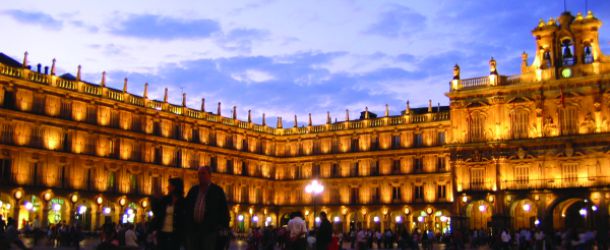Cruises to Salamanca take place along Portugal and Spain’s River of Gold, the Douro, so it’s only fitting that during your Douro river cruise, you’ll often have the opportunity to visit Spain’s Golden City, too. Always rewarding, river cruises to Salamanca offer visitors the chance to explore a city brimming with culture and architectural wonders.
Salamanca’s location on a Roman road sealed its reputation as a key commercial city early on and after the fall of the Roman Empire, it continued to hold strategic importance. After falling into the hands of the local Alan tribes it was conquered by the Visigoths, then the Moors in 712AD. The Battle of Simancas in 939 saw it become Christian again and in 1218 the city enjoyed one of its most important historic moments, when its university was granted a royal charter by Alfonso IX of Leon, leading it to become one of Europe’s most important universities. The University remained central to Salamanca’s history and its most important building until the 18th century, when it was joined by the new baroque cathedral and the city’s new main square, Plaza Mayor. In the 19th century, it was the scene of one of the key conflicts of the Napoleonic campaigns, the Battle of Salamanca, during which parts of it were seriously damaged. It also enjoyed a prominent role in the Spanish Civil War, temporarily serving as the country’s capital. In 1988, thanks to its long history, Salamanca’s old city was declared a UNESCO Heritage Site and visitors today can enjoy a fascinating journey through its past.
What not to miss on cruises to Salamanca
Plaza Mayor
As you’ve just read, Salamanca’s main square was an 18th century addition and today, it’s very much the city’s heart and so a must see. It’s one of the largest town or city squares in Spain and lined with some spectacular examples of the city’s architecture and plenty of good places to eat and drink. There’s no other place which offers those on river voyages to Salamanca a better glimpse of city life in action and it’s a great place to begin your exploration of the city, as exits lead from each of its four corners to different areas.
The cathedrals
Despite the fact that neither one of them is really new, the cathedrals are known locally as the Old Cathedral and the New Cathedral and it makes good sense to explore them both together, as they’re included in the same ticket price and you visit the old by first entering the new one. Both offer some amazing architecture and the chance to scale the roofs and tower for a spectacular view of the city, but the old cathedral really is something special and built on a grand scale. At over 500 years old the ‘new’ cathedral is hardly that new, but it has been added to and built upon over the centuries. Look carefully and you’ll even spot a stone-carved astronaut.
Puente Romano
One of the city’s oldest attractions, this Roman bridge, which was part of an ancient Roman road, dates all the way back to the first century and crosses the Tormes River. Not surprising then, that it’s one of Spain’s national monuments. These days, it’s pedestrian-only, so you won’t have to worry about motorised traffic when you cross it. To give you an idea of the bridge’s size, there are 26 arches along its length, which was quite something the best part of 2,000 years ago.
Salamanca University
This building is central to the city’s history, so all river cruises to Salamanca should certainly include a visit to it. Once the pride of Europe’s educational community, almost 800 years later it’s still attended by 35,000 students and its library is the oldest in Spain and home to over a quarter of a million books. The university offers fascinating, cobbled walk through the history of a town with a fine academic pedigree and the architecture’s something special too.
St Stephen’s Convent
River cruises to Salamanca offer some beautiful buildings but this fascinating 16th century structure surely ranks among one of the most fascinating places you can visit. Though it was built in the gothic style, it has Plateresque and Baroque features too and even before you enter, you’ll be wowed by its stunning façade, a sort of intricate stone tapestry. Inside, there are three beautiful cloisters to examine and a pantheon which is home to the tombs of key Dominican priests from throughout the building’s history.
By Simon Brotherton
Google



